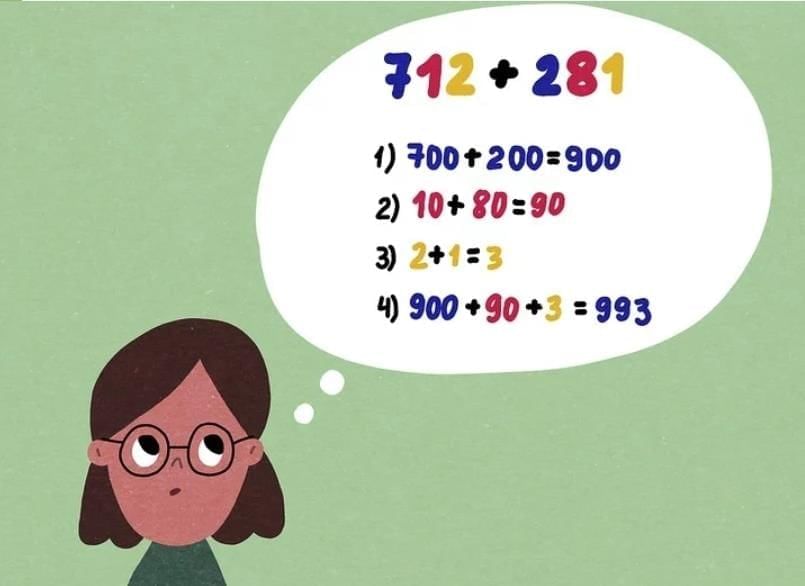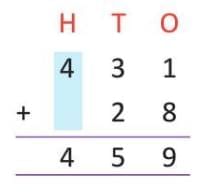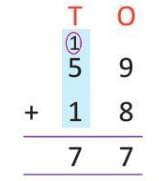Addition Chapter Notes | Mathematics Class 3 ICSE PDF Download
Introduction
Addition is like putting things together to find out how many you have in total. Imagine you have some toys, and you get more toys as a gift. To know how many toys you have now, you add the number of toys you already have to the number of new toys. In math, we use the plus sign (+) to show addition. For example, if you have 2 apples and get 3 more, you add 2 + 3 to get 5 apples. Addition helps us combine numbers to find a bigger number, called the sum. Addends are the numbers that you add together in an addition problem.
Example: You have 5 pencils, and your friend gives you 5 more. How many pencils do you have now?
5 (pencils you had) + 5 (new pencils) = 10 pencils.
The answer, 10, is the sum.
Addition of Numbers (Without Carry Over)
You just add the digits in the same place (ones with ones, tens with tens) to get the sum.
Steps:
- Write the numbers one below the other, with ones digits lined up.
- Add the ones digits first.
- If there are tens digits, add those next.
- Write the final answer.
Example: Add 23 + 45
- Write it like this:
Ones place: 3 + 5 = 8
- Tens place: 2 + 4 = 6
- The answer is 68. Since 3 + 5 = 8 (less than 10) and 2 + 4 = 6 (less than 10), there’s no carry over.
- Example: Add 431 + 28
- Ones: 1 + 8 = 9
- Tens: 3 + 2 = 5
- Hundred: 4 + 0 = 4
- Answer: 28
Addition of Numbers (With Carry Over)
When the sum of digits in one place (like ones or tens) is 10 or more, you need to carry over to the next place. This is called addition with carry over.
Steps:
- Write the numbers one below the other, lining up the ones digits.
- Add the ones' digits. If the sum is 10 or more, write the ones digit of the sum and carry the tens digit to the next place.
- Add the tens digits (including carried-over number).
- Write the final answer.
Example: Add 27 + 38
- Ones: 9 + 8 = 17. Write 7 in the ones place, carry 1 to the tens place.
- Tens: 5 + 1 + 1 (carried over) = 7
- Answer: 77
Addition Facts
Addition facts are simple addition problems that you should know by heart. They help you add faster.
Some Addition Facts:
- Two or more numbers can be added in any order.
For example, 246 + 132 = 378 and 132 + 246 = 378 - If 0 is added to a number, the sum will be the same number itself.
For example, 356 + 0 = 356 and 0 + 229 = 229 - If 1 is added to a number, the sum will be the next number (successor).
For example, 458 + 1 = 459 and 1 + 715 = 716
Addition Using Expanded Form
Every number can be broken into its parts (tens and ones). This is called expanded form. For example, 34 is 30 (tens) + 4 (ones). Using expanded form makes addition easier because you add the tens and ones separately.
Steps:
- Write both numbers in expanded form.
- Add the tens together.
- Add the ones together.
- Add the results to get the sum.
Example: Add 43 + 25
- Expanded form: 43 = 40 + 3 and 25 = 20 + 5
- Add tens: 40 + 20 = 60
- Add ones: 3 + 5 = 8
- Add them: 60 + 8 = 68
- Answer: 68
Example: Add 232 + 453 + 172
Answer: 857
Estimating the Sum
Estimating means guessing the sum by rounding numbers to the nearest 10. This helps you check if your answer makes sense or to get a quick idea of the sum.
Steps:
- Round each number to the nearest 10.
- Add the rounded numbers.
- The result is your estimated sum.
Example: Estimate 36 + 27
- Round 36 to 40 (since 36 is closer to 40 than 30).
- Round 27 to 30 (since 27 is closer to 30 than 20).
- Add: 40 + 30 = 70
- Estimated sum: 70
(The actual sum is 63, so 70 is close and helps you check.)
Example: Estimate 52 + 19
- Round 52 to 50.
- Round 19 to 20.
- Add: 50 + 20 = 70
- Estimated sum: 70
Word Problems
Word problems are stories that ask you to add numbers to find an answer. You need to read carefully to find the numbers and what they mean.
Steps:
- Read the problem and find the numbers to add.
- Decide if you need to add without or with carry over.
- Solve the addition.
- Write the answer with the correct unit (like books, rupees, etc.).
Example: Ria has 23 marbles, and Sam has 19 marbles. How many marbles do they have together?
- Numbers: 23 and 19
- Add: 23 + 19
- Ones: 3 + 9 = 12. Write 2, carry 1.
- Tens: 2 + 1 + 1 = 4
- Answer: 42
- They have 42 marbles together.
Example: In a fair, there are 256 men, 232 women and 208 children. How many people are there in the fair?
Sol: Number of men in the fair = 256
Number of women in the fair = 232
Number of children in the fair = 208
∴ Total number of people in the fair
= 256 + 232 + 208 = 696
So, there are 696 people in the fair.
Addition of 2-Digit Numbers Mentally

You can add two 2-digit numbers in your head by breaking them into tens and ones or using addition facts. This is faster than writing.
Method 1
Break the numbers to be added into tens and ones. Add the tens and ones separately. Then, add the numbers to get the final sum.
Example : Add 36 and 20.Sol: 36 + 20 = 30 + 6 + 20 (breaking into tens and ones)
= (30 + 20) + 6 (adding tens and ones separately)
= 50 + 6 = 56
Method 2
Round off the bigger number to the nearest 10. Add the two numbers and then correct the sum.
Example 1: Add 87 and 94.
Sol: Round off 94 to 90. (94 – 90 = 4)
Add 90 to 87.
87 + 90 = 177
As we added 4 less than 94, correct the answer by adding 4 to 177.
So, 177 + 4 = 181.
Top Tip:
You may select the addend you find easier to round off and then correct the sum accordingly.
Example 2: Add 34 + 25 mentally
Sol:
- Tens: 30 + 20 = 50
- Ones: 4 + 5 = 9
- Total: 50 + 9 = 59
Practice Questions
- Add 32 + 46 (without carry over).
- Add 58 + 37 (with carry over).
- Use expanded form to add 61 + 28.
- Estimate the sum of 44 + 29.
- Solve this word problem: A basket has 24 apples, and you add 18 more. How many apples are in the basket now?
|
67 docs|9 tests
|
FAQs on Addition Chapter Notes - Mathematics Class 3 ICSE
| 1. What is the difference between addition without carry over and addition with carry over? |  |
| 2. How can I estimate the sum of two numbers? |  |
| 3. What are some addition facts that can help improve my skills? |  |
| 4. How can I add 2-digit numbers mentally? |  |
| 5. What are some common word problems involving addition for 3rd graders? |  |





















